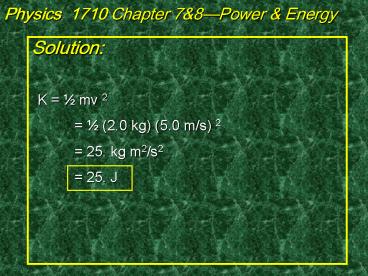Solution: - PowerPoint PPT Presentation
Title:
Solution:
Description:
Unit of power = Joule/second = Watt. Physics 1710 Chapter 7&8 Power & Energy ... Power: Watt = Joule/second. James Watt. Watt's Steam Engine 1774 ... – PowerPoint PPT presentation
Number of Views:25
Avg rating:3.0/5.0
Title: Solution:
1
Physics 1710 Chapter 78Power Energy
0
- Solution
K ½ mv 2 ½ (2.0 kg) (5.0 m/s) 2 25. kg
m2/s2 25. J
2
Physics 1710 Chapter 78Power Energy
0
- What is the minimum height from which a small
rolling ball must be started from rest so that it
will complete a loop-the-loop?
h
3
Physics 1710 Chapter 78Power Energy
0
- What is the minimum height from which a small
rolling ball must be started from rest so that it
will complete a loop-the-loop?
Peer Instruction Time
4
Physics 1710 Chapter 78Power Energy
0
- What is the minimum height from which a small
rolling ball must be started from rest so that it
will complete a loop-the-loop?
v2/R g K U ½ mv 2 mg(h-R) v 2 2 g
(h-R) g R 2g (h-R) h 3R
h
5
Physics 1710 Chapter 78Power Energy
0
- What is the minimum height from which a small
rolling ball must be started from rest so that it
will complete a loop-the-loop?
K ½ mv 2 ½ (2.0 kg) (5.0 m/s) 2 25. kg
m2/s2 25. J
6
Physics 1710 Chapter 78Power Energy
0
- 1' Lecture
- Power is the time rate of change in energy.
Power Watt Joule/second - Potential Energy U is the energy stored in a
system and may later produce work. - The Potential Energy is equal to the negative
of the work done on the system to put it in its
present state. - The sum of all energy, potential and kinetic,
is conserved in an isolated system.
7
Physics 1710 Chapter 78Power Energy
0
- Power
- P dE/dt
- Power is the time rate of change in the energy
of a system, the rate of work down on or by the
system. - Unit of power Joule/second Watt
8
Physics 1710 Chapter 78Power Energy
0
- Unit of Work and Energy
- F ? d N?m Joule J
Joule
9
Physics 1710 Chapter 78Power Energy
0
- Power Watt Joule/second
Watts Steam Engine 1774
10
Physics 1710 Chapter 78Power Energy
0
- Power
- P dE/dt
- P ?E/?t
- ?E P ?t
- ?E (100 W)(3600 s)
- ?E 360 000 J 360 kJ
11
Physics 1710 Chapter 78Power Energy
0
- Potential Energy
- W ? Fd r
- U -W
- Potential Energy is the negative of the work
required to put the system in the current state.
12
Physics 1710 Chapter 78Power Energy
0
- Potential Energy
U - (- F h) m g h
13
Physics 1710 Chapter 78Power Energy
0
- Example Elevated Mass
- F -mg
- Potential Energy
- Ug -?0hFdy -?0h(- mg) dy
- Ug mg?0h dy mgh
- Thus, the potential energy stored in an elevated
mass is proportional to the height h and the
weight of the mass.
14
Physics 1710 Chapter 78Power Energy
0
- Where does the energy come from to produce
electrical power in a hydroelectric dam?
Peer Instruction Time
15
Physics 1710 Chapter 78Power Energy
0
- Potential Energy
U m g h P dU/dt mg dh/dt mg (100.
kg)(9.8N/kg) 98.0 N dh/dt 10 m/10 s 1
m/s P 98. W
16
Physics 1710 Chapter 78Power Energy
0
- Relationship Between F and U
- U -? Fd r
- So
- U -? Fx dx Fy dy Fz dz
- Then
- Fx -dU/dx Fy -dU/dy Fz -dU/dz
- F -?U
- F -gradient of U
17
Physics 1710 Chapter 78Power Energy
0
- Example Mass on a Spring
- Potential Energy
- U ½ k x 2
- F dU/dx
- F -½ k dx2/dx
- F -k x
- Thus, the force is equal to the negative of the
gradient of the potential energy.
18
Physics 1710 Chapter 78Power Energy
0
- The Force is equal to the negative gradient of
the potential energy - F -?U
- Fx -?U/?x
- Fy -?U/?y
- Fz -?U/?z
19
Physics 1710 Chapter 8 Potential Energy and
Conservation
0
- Example Ball on a slope
- h ax by
- U mgh
- Fx -?U/?x -?(mgh)/?x -mg?h/?x
- Similarly
- Fy -?U/?y -mg b
- Thus, F -mg( a i b j )
20
Physics 1710 Chapter 78Power Energy
0
- Conservation of Energy
- The sum of all energy in a system is conserved,
i.e. remains the same. - E U K
21
Physics 1710 Chapter 78Power Energy
0
- Example Pendulum
- U mg h
- h L(1- cos ? )
- U mg L(1- cos ? )
- K ½ m v 2
- ½ m (Ld ?/dt) 2
- E mg L(1- cos ? ) ½ m (Ld ?/dt) 2
- constant
22
Physics 1710 Chapter 78Power Energy
0
- Thought (Gedanken) Experiment
- Why does a pendulum stop moving?
23
Physics 1710 Chapter 78Power Energy
0
- Dissipative (non-conservative) Forces
- W ? Fd r
- ? (C vx 2 )dx
- ? (C vx 2 )(dx /dt) dt
- ? (C vx 3 )dt
- E U K -W
24
Physics 1710 Chapter 78Power Energy
0
- Summary
- The Potential Energy is equal to the negative of
the work done on the system to put it in its
present state. - U -? Fd r
- The sum of all energy, potential and kinetic,
of a system is conserved, in the absence of
dissipation. - E U K W
- F - ?U
- P dE/dt































